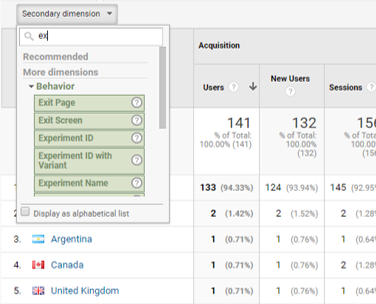Explained: The Duty and Interpretation of a 'Secondary Dimension' in Google Analytics
Explained: The Duty and Interpretation of a 'Secondary Dimension' in Google Analytics
Blog Article
Navigating the Midst of Second Dimension in Google Analytics: An In-depth Exploration on Its Performance
In the realm of digital analytics, the ins and outs of information analysis typically hold the secret to opening valuable insights. Within the expansive toolkit of Google Analytics lies an attribute that acts as a concealed treasure for those that look for a much deeper understanding of user behavior and internet site performance. Additional measurements, though seemingly simple in the beginning glimpse, nurture a wide range of untapped potential waiting to be used. As we start this journey to check out the nuanced performance of secondary measurements, we will certainly discover how this attribute can light up patterns, reveal correlations, and ultimately lead the means for notified decision-making in the digital landscape.
Understanding Additional Dimensions in Google Analytics

Comprehending just how secondary measurements job is critical for leveraging the full power of Google Analytics. By integrating key metrics with second dimensions, you can get beneficial insights that drive notified decision-making and optimization strategies.
Leveraging Second Measurements for Data Evaluation
Building upon the foundational understanding of exactly how second dimensions improve information evaluation in Google Analytics, the utilization of these added layers of details becomes paramount in removing important understandings for informed decision-making and optimization approaches. By leveraging additional measurements, experts can delve much deeper right into the performance metrics by including even more context to the key dimensions, hence discovering surprise patterns and relationships that might not be obvious initially glimpse. This much deeper level of analysis allows services to much better understand customer behavior, recognize patterns, and determine areas for enhancement.
Moreover, second dimensions offer a more comprehensive sight of the information, permitting division based on various specifications such as demographics, devices, web traffic resources, and a lot more. This division assists in a much more granular analysis, allowing companies to customize their approaches and projects to certain audience segments for boosted targeting and customization. Essentially, the tactical use of additional dimensions empowers companies to make data-driven decisions that drive development and success in the electronic landscape.
Advanced Methods for Additional Measurement Application
Exploring intricate techniques to harness the full potential of additional measurements in Google Analytics elevates the deepness and refinement of information evaluation for strategic decision-making. One sophisticated technique for carrying out secondary dimensions is the usage of custom dimensions. Furthermore, combining secondary dimensions with sophisticated sectors can give also a lot more granular insights by using numerous layers of division to the data.
Interpreting Insights With Additional Measurements

When interpreting insights through second dimensions, it is necessary to consider the context of the data and exactly how various measurements interact with each other. As an example, understanding which certain traffic sources cause higher conversion prices or identifying which devices individuals prefer for making purchases can give workable understandings for enhancing marketing projects and boosting general website performance. By carefully examining the information with second measurements in mind, services can make enlightened choices that drive meaningful outcomes and enhance their electronic existence.
Enhancing Efficiency With Second Dimensions

One crucial way to optimize efficiency with additional dimensions is by segmenting data much more granularly. This allows you to separate specific factors that may be influencing your metrics and gain a much better understanding of what drives success or failure in your digital initiatives. As an example, by top article incorporating second dimensions such as 'gadget group' and 'landing page,' you can determine which gadget types are most efficient for specific touchdown web pages, enabling you to tailor your approaches accordingly.
Additionally, using secondary dimensions can assist you determine fads, patterns, and correlations that might not appear when analyzing data with primary dimensions alone. This deeper degree of evaluation can lead to even more enlightened decision-making and eventually improve the general efficiency of your internet site or electronic advertising and marketing projects.
Conclusion
To conclude, secondary dimensions in Google Analytics play a crucial function in enhancing data analysis and offering deeper insights right into web site performance. By using sophisticated techniques and translating the information successfully, businesses can optimize their techniques and enhance total efficiency. Comprehending the capability of second measurements is necessary for making educated decisions and driving success in the digital landscape.
By leveraging second dimensions, experts can dig much deeper into the performance metrics check out this site by including even more context to the primary dimensions, therefore discovering covert patterns and relationships that might not be noticeable at initial glimpse. One sophisticated technique for applying secondary measurements is the use of custom-made read review measurements.Having actually grasped advanced techniques like custom-made measurements and regex for additional measurement application in Google Analytics, the following vital action is translating the important insights derived through these advanced information division approaches. Translating understandings through second dimensions involves examining the partnerships between the primary and secondary measurements picked, uncovering patterns, trends, and relationships that might not be instantly obvious when looking at the data in its totality.When analyzing understandings through additional dimensions, it is important to think about the context of the data and how various dimensions communicate with each other.
Report this page